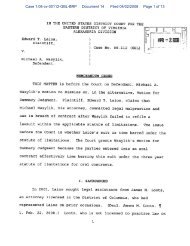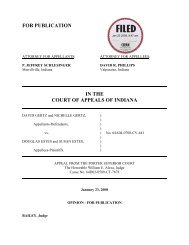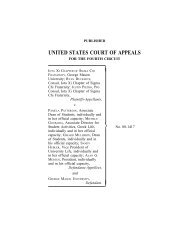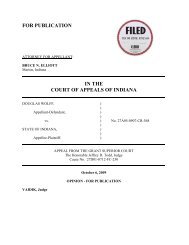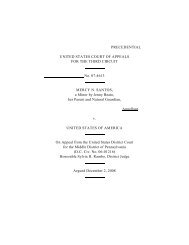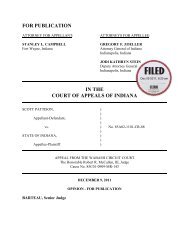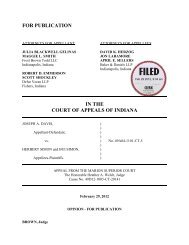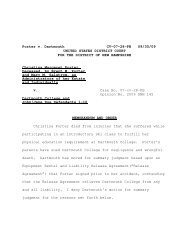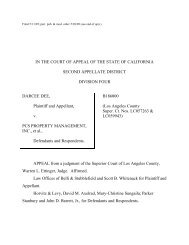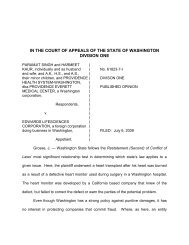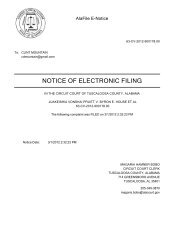LaPorte Community School Corporation v. Maria ... - State of Indiana
LaPorte Community School Corporation v. Maria ... - State of Indiana
LaPorte Community School Corporation v. Maria ... - State of Indiana
Create successful ePaper yourself
Turn your PDF publications into a flip-book with our unique Google optimized e-Paper software.
FOR PUBLICATION<br />
ATTORNEYS FOR APPELLANT: ATTORNEYS FOR APPELLEE:<br />
WILLIAM H. KELLEY KENNETH J. ALLEN<br />
DARLA S. BROWN ROBERT D. BROWN<br />
Kelley Belcher & Brown Kenneth J. Allen & Associates, P.C.<br />
Bloomington, <strong>Indiana</strong> Valparaiso, <strong>Indiana</strong><br />
IN THE<br />
COURT OF APPEALS OF INDIANA<br />
LAPORTE COMMUNITY SCHOOL )<br />
CORPORATION, )<br />
)<br />
Appellant, )<br />
)<br />
vs. ) No. 46A04-1001-CT-4<br />
)<br />
MARIA ROSALES, Individually and as the )<br />
Parent and Natural Guardian <strong>of</strong> Juan Loera, a )<br />
Minor Child Deceased, )<br />
)<br />
Appellee. )<br />
BARNES, Judge<br />
APPEAL FROM THE LAPORTE CIRCUIT COURT<br />
The Honorable Thomas Alevizos, Judge<br />
Cause No.46C01-0701-CT-39<br />
October 27, 2010<br />
OPINION - FOR PUBLICATION
Case Summary<br />
The <strong>LaPorte</strong> <strong>Community</strong> <strong>School</strong> <strong>Corporation</strong> appeals a judgment in favor <strong>of</strong> <strong>Maria</strong><br />
Rosales (“Rosales”), individually and as the parent and natural guardian <strong>of</strong> Juan Loera.<br />
We affirm in part, reverse in part, and remand.<br />
Issues<br />
The <strong>School</strong> raises four issues, which we restate as follows:<br />
I. whether the trial court properly admitted an expert<br />
witness‟s testimony;<br />
II. whether the trial court properly denied the <strong>School</strong>‟s<br />
motion for judgment on the evidence on the issue <strong>of</strong><br />
negligence;<br />
III. whether the trial court properly granted Rosales‟s<br />
motion for judgment on the evidence on the issue <strong>of</strong><br />
contributory negligence; and<br />
IV. whether the trial court properly instructed the jury<br />
regarding negligence.<br />
Facts<br />
Hailmann Elementary <strong>School</strong> (“Hailmann”) is part <strong>of</strong> the <strong>LaPorte</strong> <strong>Community</strong><br />
<strong>School</strong> <strong>Corporation</strong> (“<strong>School</strong>”). <strong>Indiana</strong> <strong>State</strong> Board <strong>of</strong> Education regulations required<br />
the <strong>School</strong> to prepare an emergency preparedness plan and crisis intervention plan. See<br />
511 I.A.C. 4-1.5-7, 511 I.A.C. 6.1-2-2.5. Hailmann‟s Safe <strong>School</strong>s Plan Emergency<br />
Crisis Intervention (“Plan”) required the school nurse to develop and coordinate a first<br />
aid team, coordinate an annual CPR and first aid training session, and provide a list <strong>of</strong><br />
CPR trained individuals to the principal, Barbara Maitland. In 2006, Hailmann shared a<br />
2
school nurse, Karen Huskey, with another elementary school. Prior to September 2006,<br />
Huskey had never seen the <strong>School</strong>‟s Plan and Maitland had never talked to her about the<br />
Plan or CPR training. Prior to September 2006, Huskey had not coordinated a first aid<br />
team, coordinated annual CPR training at Hailmann, or prepared a list <strong>of</strong> CPR trained<br />
individuals at Hailmann. Huskey was assigned to the other elementary school on the day<br />
<strong>of</strong> these events.<br />
On September 12, 2006, Juan Loera was nine years old and in third grade at<br />
Hailmann. Thomas Muller, head custodian at Hailmann, was in the cafeteria during<br />
Juan‟s lunch period. Muller told Juan and other boys at his table to calm down and eat<br />
because they were joking around and laughing. A minute later, another student informed<br />
Muller that Juan was choking. Muller sent the noon assistant, Rhonda Smith, to get help<br />
and went to Juan‟s table. Juan had his hand by his throat and told Muller, “I‟m choking.”<br />
Tr. p. 378. Muller leaned Juan over the table and gave him three or four “back blows,”<br />
and Juan vomited on the table. Id.<br />
Maitland and Sandra McEathron, the school secretary, arrived in the cafeteria.<br />
McEathron saw that Juan was standing with his hand in his mouth. McEathron attempted<br />
to do the Heimlich maneuver but was unsuccessful in removing the obstruction.<br />
Maitland sent McEathron to make an “All-Call” announcement for anyone who knew the<br />
Heimlich maneuver to report to the cafeteria. Id. at 403.<br />
Muller returned to Juan when he heard the “All-Call” announcement. Id. at 381.<br />
Muller saw that they were struggling to do the Heimlich maneuver on Juan, and Muller<br />
then attempted the Heimlich maneuver on Juan. Several other staff members and<br />
3
teachers also responded to the “All-Call” and attempted to do the Heimlich maneuver on<br />
Juan. At some point, Juan lost consciousness, and they put Juan on the ground and<br />
attempted to do stomach thrusts on him. They also did finger sweeps <strong>of</strong> Juan‟s mouth<br />
and throat. Another teacher picked Juan up <strong>of</strong>f the floor and did the Heimlich maneuver<br />
on him until a police <strong>of</strong>ficer arrived. The police <strong>of</strong>ficer unsuccessfully attempted<br />
stomach thrusts and did chest compressions on Juan until the ambulance arrived.<br />
Paramedic Jeff Koon found that Juan did not have a pulse or respiration. Koon opened<br />
Juan‟s airway with a laryngoscope blade and removed a large piece <strong>of</strong> corn dog with<br />
forceps. According to Koon, the corn dog was not lodged in Juan‟s trachea; it was in<br />
Juan‟s “oral cavity,” which includes the throat. Id. at 499. Despite the school and<br />
emergency workers‟ efforts, Juan died later at the hospital.<br />
On October 23, 2006, Rosales filed a tort claim notice with the <strong>School</strong>. On<br />
January 26, 2007, Rosales filed a complaint for wrongful death against the <strong>School</strong>, and in<br />
January 2008, Rosales filed an amended complaint for wrongful death against the <strong>School</strong><br />
alleging negligence and emotional distress by Rosales. 1 In response, the <strong>School</strong> alleged<br />
in part that Rosales‟s damages were a proximate result <strong>of</strong> Juan‟s contributory negligence.<br />
The <strong>School</strong> filed a motion for summary judgment, and in response to the motion<br />
for summary judgment, Rosales submitted an affidavit <strong>of</strong> Charles Hibbert. The <strong>School</strong><br />
filed a motion to strike Hibbert‟s summary judgment affidavit and sought to exclude his<br />
trial testimony because, according to the <strong>School</strong>, his testimony was “unreliable and not<br />
1 Rosales also included Alfred Loera, Juan‟s father, as a defendant in the action. The trial court later<br />
granted a default judgment against Alfred.<br />
4
ased on anything other than his opinion.” App. p. 124. The trial court found that<br />
Hibbert was an expert regarding school safety and school emergency plans, that any lack<br />
<strong>of</strong> reliability <strong>of</strong> his conclusions could be explored during cross examination at trial, and<br />
that the danger <strong>of</strong> unfair prejudice compared to the probative value <strong>of</strong> the testimony was<br />
small. Consequently, the trial court denied the <strong>School</strong>‟s motion to strike the affidavit<br />
from the summary judgment proceedings and to exclude Hibbert‟s trial testimony. The<br />
trial court also denied the <strong>School</strong>‟s motion for summary judgment on Rosales‟s<br />
negligence claim but granted summary judgment to the <strong>School</strong> on Rosales‟s emotional<br />
distress claim.<br />
A jury trial was held in September 2009. During the trial, Hibbert was unavailable<br />
to testify, and the <strong>School</strong> objected to the admission <strong>of</strong> his deposition. The trial court<br />
overruled the <strong>School</strong>‟s objection and allowed Hibbert‟s deposition to be read to the jury.<br />
At the close <strong>of</strong> Rosales‟s case, the <strong>School</strong> moved for judgment on the evidence on the<br />
issue <strong>of</strong> negligence, and the trial court denied the motion. At the close <strong>of</strong> the evidence,<br />
Rosales moved for judgment on the evidence regarding the <strong>School</strong>‟s contributory<br />
negligence defense, and the trial court granted Rosales‟s motion. Over the <strong>School</strong>‟s<br />
objections, the trial court gave Instruction Number 22 and Instruction Number 26<br />
regarding negligence. The jury returned a verdict in favor <strong>of</strong> Rosales and against the<br />
<strong>School</strong> in the amount <strong>of</strong> $5,000,000. Pursuant to the <strong>Indiana</strong> Tort Claims Act, <strong>Indiana</strong><br />
Code Section 34-13-3-4, the verdict was reduced to $500,000, and judgment was entered<br />
in that amount. The <strong>School</strong> filed a motion to correct error, which was deemed denied.<br />
The <strong>School</strong> now appeals.<br />
5
Analysis<br />
I. Hibbert’s Testimony<br />
The first issue is whether the trial court properly admitted Hibbert‟s deposition at<br />
the trial. The determination <strong>of</strong> the admissibility <strong>of</strong> expert testimony is a matter within the<br />
sound discretion <strong>of</strong> the trial court. Lytle v. Ford Motor Co., 696 N.E.2d 465, 470 (Ind.<br />
Ct. App. 1998), trans. denied. We will reverse only for an abuse <strong>of</strong> that discretion. Id.<br />
Hibbert is the president <strong>of</strong> Hibbert Safety <strong>School</strong> Consulting, LLC. He testified<br />
that he has extensive experience in “evaluating, reviewing and assessing school safety<br />
plans or guidelines.” Tr. p. 275. He served as an external consultant to the <strong>Indiana</strong><br />
Department <strong>of</strong> Education to evaluate school safety plans after the <strong>State</strong> Board <strong>of</strong><br />
Education implemented the standard for schools in <strong>Indiana</strong>. He retired from the<br />
Metropolitan <strong>School</strong> District <strong>of</strong> Wayne Township in <strong>Indiana</strong>polis after working as the<br />
coordinator <strong>of</strong> safety and transportation services for twenty-one years.<br />
Hibbert testified in the deposition that the <strong>School</strong> “failed to meet the standard <strong>of</strong><br />
care required <strong>of</strong> schools in <strong>Indiana</strong> to have in place a plan to deal with foreseeable<br />
emergencies, such as a child choking.” Id. at 279. According to Hibbert‟s deposition<br />
testimony, although the <strong>School</strong>‟s Plan was reasonable, the <strong>School</strong> failed to properly<br />
implement the Plan, “which was a breach <strong>of</strong> the standard <strong>of</strong> care required <strong>of</strong> them and by<br />
them.” Id. Hibbert testified that, while no <strong>Indiana</strong> statutes require schools to have a<br />
certain percentage <strong>of</strong> staff to have training in CPR or first aid, in his opinion:<br />
the reasonable standard <strong>of</strong> care is that people who are<br />
involved in the supervision and have responsibility in a daily<br />
basis for children, will have reasonable levels <strong>of</strong> training in<br />
6
Id. at 293.<br />
regards to those things that can and will occur. Particularly, a<br />
choking child. A choking child is a very common experience<br />
and particularly in elementary schools.<br />
The <strong>School</strong> objected to the admission <strong>of</strong> Hibbert‟s deposition testimony. On<br />
appeal, the <strong>School</strong> argues that Hibbert‟s testimony was unreliable because his statements<br />
lacked specificity, could not be empirically tested, and failed under Daubert 2 standards.<br />
The <strong>School</strong> also argues that Hibbert‟s opinion was unsupported and that his testimony<br />
was unnecessary to show that the <strong>School</strong> failed to implement its Plan.<br />
The <strong>School</strong> relies upon <strong>Indiana</strong> Evidence Rule 702, which provides:<br />
(a) If scientific, technical, or other specialized knowledge<br />
will assist the trier <strong>of</strong> fact to understand the evidence<br />
or to determine a fact in issue, a witness qualified as an<br />
expert by knowledge, skill, experience, training, or<br />
education, may testify thereto in the form <strong>of</strong> an<br />
opinion or otherwise.<br />
(b) Expert scientific testimony is admissible only if the<br />
court is satisfied that the scientific principles upon<br />
which the expert testimony rests are reliable.<br />
Where an expert‟s testimony is based upon the expert‟s skill or experience rather<br />
than on the application <strong>of</strong> scientific principles, the proponent <strong>of</strong> the testimony must only<br />
demonstrate that the subject matter is related to some field beyond the knowledge <strong>of</strong> lay<br />
persons and that the witness possesses sufficient skill, knowledge, or experience in the<br />
field to assist the trier <strong>of</strong> fact to understand the evidence or to determine a fact in issue.<br />
Lytle, 696 N.E.2d at 469-70. However, when the expert‟s testimony is based upon<br />
2 Daubert v. Merrell Dow Pharmaceuticals, Inc., 509 U.S. 579, 113 S. Ct. 2786 (1993).<br />
7
scientific principles, the proponent <strong>of</strong> the testimony must also establish that the scientific<br />
principles upon which the testimony rests are reliable. Id. (citing Ind. Evidence Rule<br />
702(b)).<br />
We conclude that Hibbert‟s expert opinion is not governed by scientific principles<br />
and, therefore, is not subject to <strong>Indiana</strong> Evidence Rule 702(b)‟s reliability requirements.<br />
His opinion was based solely on his knowledge and experience and his review <strong>of</strong> the<br />
facts surrounding Juan‟s choking. Hibbert‟s expert opinion was based on specialized<br />
knowledge and not scientific principles.<br />
The <strong>School</strong> also argues that Hibbert‟s experience was “somewhat limited.”<br />
Appellant‟s Br. p. 30. “[T]he specific knowledge <strong>of</strong> an expert witness is neither<br />
determinative <strong>of</strong> the witness‟ qualification as an expert nor the admissibility <strong>of</strong> his<br />
opinion into evidence.” McIntosh v. Cummins, 759 N.E.2d 1180, 1185 (Ind. Ct. App.<br />
2001), trans. denied. “A witness‟ competency is determined by his knowledge <strong>of</strong> the<br />
subject matter generally, and his knowledge <strong>of</strong> the specific subject <strong>of</strong> inquiry goes to the<br />
weight to be accorded his opinion, not its admissibility.” Id. Hibbert‟s experience and<br />
training went to the weight <strong>of</strong> his testimony not its admissibility.<br />
Based upon his experience and training, Hibbert qualified as an expert. The<br />
subject matter <strong>of</strong> his testimony—school safety—was a topic beyond the knowledge <strong>of</strong> lay<br />
persons and assisted the trier <strong>of</strong> fact in understanding the evidence or determining a fact<br />
in issue. Consequently, Hibbert‟s expert opinion was admissible, and the trial court did<br />
not abuse its discretion in admitting it into evidence.<br />
II. <strong>School</strong>’s Motion for Judgment on the Evidence<br />
8
The next issue is whether the trial court properly denied the <strong>School</strong>‟s motion for<br />
judgment on the evidence on the issue <strong>of</strong> negligence. 3 “The standard <strong>of</strong> review for a<br />
challenge to a ruling on a motion for judgment on the evidence is the same as the<br />
standard governing the trial court in making its decision.” Smith v. Baxter, 796 N.E.2d<br />
242, 243 (Ind. 2003). Judgment on the evidence is proper only “where all or some <strong>of</strong> the<br />
issues . . . are not supported by sufficient evidence.” Id. (quoting Ind. Trial Rule 50(A)).<br />
We look only to the evidence and the reasonable inferences drawn most favorable to the<br />
non-moving party. Id. The motion should be granted only where there is no substantial<br />
evidence supporting an essential issue in the case. Id. If there is evidence that would<br />
allow reasonable people to differ as to the result, judgment on the evidence is improper.<br />
Id.<br />
Negligence is comprised <strong>of</strong> the following three elements: (1) a duty owed to the<br />
plaintiff by the defendant; (2) a breach <strong>of</strong> that duty by the defendant; and (3) an injury to<br />
the plaintiff proximately caused by that breach. McClyde v. Archdiocese <strong>of</strong> <strong>Indiana</strong>polis,<br />
752 N.E.2d 229, 232 (Ind. Ct. App. 2001). In cases involving an alleged breach <strong>of</strong> a<br />
school‟s duty owed to its students, <strong>Indiana</strong> courts have imposed a standard <strong>of</strong> care that is<br />
the level <strong>of</strong> care an ordinary, prudent person would exercise under the same or similar<br />
3 Rosales argues that the <strong>School</strong> waived appeal <strong>of</strong> the denial <strong>of</strong> its motion for judgment on the evidence<br />
by thereafter presenting evidence. See Ind. Trial Rule 50(A)(6) (“A motion for judgment on the evidence<br />
made at one stage <strong>of</strong> the proceedings is not a waiver <strong>of</strong> the right <strong>of</strong> the court or <strong>of</strong> any party to make such<br />
motion . . . except that error <strong>of</strong> the court in denying the motion shall be deemed corrected by evidence<br />
thereafter <strong>of</strong>fered or admitted.”). However, the <strong>School</strong> renewed its motion for judgment on the evidence<br />
after the presentation <strong>of</strong> its evidence. A defendant does not waive appellate review <strong>of</strong> a trial court‟s<br />
denial <strong>of</strong> motion for judgment on the evidence under Trial Rule 50(A) made at close <strong>of</strong> plaintiff‟s case,<br />
even though after denial <strong>of</strong> motion the defendant presented evidence on his or her own behalf, if the<br />
defendant renews the motion for judgment on the evidence after he or she presented evidence. Kelly v.<br />
Levandoski, 825 N.E.2d 850 (Ind. Ct. App. 2005), trans. denied.<br />
9
circumstances. Id. “Because there is „some remote risk <strong>of</strong> injury in all human existence,‟<br />
. . . the duty imposed upon <strong>Indiana</strong> schools to protect their students has been necessarily<br />
defined by the specific circumstances <strong>of</strong> each case.” Id. at 232-33 (quoting Norman v.<br />
Turkey Run Cmty. Sch. Corp., 274 Ind. 310, 316, 411 N.E.2d 614, 617 (1980)).<br />
The <strong>School</strong> focuses on the breach element and argues that there was a “complete<br />
lack <strong>of</strong> evidence” showing that it failed to confirm its conduct to the requisite standard <strong>of</strong><br />
care. Appellant‟s Br. p. 35. According to the <strong>School</strong>, there was no evidence presented<br />
that the <strong>School</strong> violated a statutory duty or failed to do what other school corporations do<br />
to prepare for medical emergencies. Rosales argues that she presented evidence<br />
demonstrating the <strong>School</strong> failed to meet the standard <strong>of</strong> care by failing to ensure that its<br />
Plan was implemented, by failing to follow the procedures in the Plan, and by failing to<br />
properly train the staff to respond to medical emergencies.<br />
Rosales presented evidence that the <strong>School</strong> developed a Plan pursuant to <strong>Indiana</strong><br />
<strong>State</strong> Board <strong>of</strong> Education regulations. See 511 I.A.C. 4-1.5-7, 511 I.A.C. 6.1-2-2.5.<br />
Hailmann‟s Plan specifically required the school nurse to develop and coordinate a first<br />
aid team, coordinate an annual CPR and first aid training session, and provide a list <strong>of</strong><br />
CPR trained individuals to the principal, Maitland. Prior to September 2006, the school<br />
nurse, Huskey, had never seen the <strong>School</strong>‟s Plan, and Maitland had never talked to her<br />
about the Plan or CPR training. Prior to September 2006, Huskey had not coordinated a<br />
first aid team, coordinated annual CPR training at Hailmann, or prepared a list <strong>of</strong> CPR<br />
trained individuals at Hailmann. Dr. Robert Stuart, an emergency room physician,<br />
testified that it was “clear” the staff was not properly trained in basic life support and that<br />
10
the staff did not perform proper procedures on a choking victim. Tr. p. 207. In Dr.<br />
Stuart‟s opinion, if the staff had been properly trained in basic life support and properly<br />
performed basic life support <strong>of</strong> Juan, Juan would have survived. Hibbert testified that,<br />
while no <strong>Indiana</strong> statutes require schools to have a certain percentage <strong>of</strong> staff to have<br />
training in CPR or first aid, in his opinion:<br />
Id. at 293.<br />
the reasonable standard <strong>of</strong> care is that people who are<br />
involved in the supervision and have responsibility in a daily<br />
basis for children, will have reasonable levels <strong>of</strong> training in<br />
regards to those things that can and will occur. Particularly, a<br />
choking child. A choking child is a very common experience<br />
and particularly in elementary schools.<br />
Given this evidence, it was for the jury to decide whether the <strong>School</strong> exercised the<br />
level <strong>of</strong> care an ordinary, prudent person would exercise under the same or similar<br />
circumstances. The trial court properly denied the <strong>School</strong>‟s motion for judgment on the<br />
evidence regarding negligence.<br />
III. Rosales’s Motion for Judgment on the Evidence<br />
The next issue is whether the trial court properly granted Rosales‟s motion for<br />
judgment on the evidence on the issue <strong>of</strong> contributory negligence. Again, “[t]he standard<br />
<strong>of</strong> review for a challenge to a ruling on a motion for judgment on the evidence is the<br />
same as the standard governing the trial court in making its decision.” Baxter, 796<br />
N.E.2d at 243. Judgment on the evidence is proper only “where all or some <strong>of</strong> the issues<br />
. . . are not supported by sufficient evidence.” Id. (quoting T.R. 50(A)). We look only to<br />
the evidence and the reasonable inferences drawn most favorable to the non-moving<br />
11
party. Id. The motion should be granted only where there is no substantial evidence<br />
supporting an essential issue in the case. Id. If there is evidence that would allow<br />
reasonable people to differ as to the result, judgment on the evidence is improper. Id.<br />
The <strong>School</strong> argues that there was sufficient evidence for the issue <strong>of</strong> Juan‟s<br />
contributory negligence to be presented to the jury. “<strong>Indiana</strong> law requires that<br />
contributory negligence on the part <strong>of</strong> the plaintiff bars any recovery against government<br />
actors.” Clay City Consol. Sch. Corp. v. Timberman, 918 N.E.2d 292, 300 n.6 (Ind.<br />
2009). Contributory negligence is “the failure <strong>of</strong> a plaintiff to exercise the reasonable<br />
care an ordinary person would for his own protection and safety.” Penn Harris Madison<br />
<strong>School</strong> Corp. v. Howard, 861 N.E.2d 1190, 1193 n.1 (Ind. 2007). “<strong>Indiana</strong> law<br />
recognizes a rebuttable presumption that children between the ages <strong>of</strong> seven and 14 are<br />
incapable <strong>of</strong> contributory negligence.” Timberman, 918 N.E.2d at 297. “[C]hildren in<br />
this age group are required to exercise due care for their own safety under the<br />
circumstances <strong>of</strong> children <strong>of</strong> like age, knowledge, judgment, and experience.” Id.<br />
The evidence demonstrated that Juan, a nine-year-old child, was eating in the<br />
school cafeteria when he choked on a corn dog. A few minutes before Juan choked,<br />
Muller warned Juan and other boys at his table to calm down and eat because they were<br />
joking around and laughing. According to Muller, the boys then calmed down. A<br />
“minute or so” later, a child approached Muller and told him that Juan was choking. Tr.<br />
p. 385. Apparently, another child had made a duck face with Pringles, and Juan laughed<br />
and choked on his food.<br />
12
The presumption is that Juan was not contributorily negligent, and we conclude<br />
that the <strong>School</strong> presented no evidence to rebut that presumption. We emphasize that the<br />
only evidence <strong>of</strong> Juan‟s conduct at the time he choked was that he laughed at another<br />
child. There was no substantial evidence presented that Juan failed to exercise the<br />
reasonable care an ordinary nine-year-old boy <strong>of</strong> like age, knowledge, judgment, and<br />
experience would for his own protection and safety. Because there was no substantial<br />
evidence <strong>of</strong> contributory negligence, the trial court properly granted Rosales‟s motion for<br />
judgment on the evidence regarding the <strong>School</strong>‟s contributory negligence defense.<br />
IV. Jury Instructions<br />
The final issue is whether the trial court properly instructed the jury regarding<br />
negligence. In reviewing a trial court‟s decision to give or refuse a tendered instruction,<br />
we consider whether the instruction: (1) correctly states the law, (2) is supported by the<br />
evidence in the record, and (3) is covered in substance by other instructions. Wal-Mart<br />
Stores, Inc. v. Wright, 774 N.E.2d 891, 893 (Ind. 2002). The trial court has discretion in<br />
instructing the jury, and we will reverse on the last two issues only when the instructions<br />
amount to an abuse <strong>of</strong> discretion. Id. When an instruction is challenged as an incorrect<br />
statement <strong>of</strong> the law, however, appellate review <strong>of</strong> the ruling is de novo. Id. at 893-94.<br />
“Jury instructions are to be considered as a whole and in reference to each other.”<br />
Timberman, 918 N.E.2d at 300. “Even when a jury is given an incorrect instruction on<br />
the law, we will not reverse the judgment unless the party seeking a new trial shows „a<br />
reasonable probability that substantial rights <strong>of</strong> the complaining party have been<br />
13
adversely affected.‟” Penn Harris Madison, 861 N.E.2d at 1195 (quoting Elmer Buchta<br />
Trucking, Inc. v. Stanley, 744 N.E.2d 939, 944 (Ind. 2001)).<br />
The first instruction at issue here is Instruction No. 22, which provided:<br />
Plaintiff has the burden <strong>of</strong> proving the following three (3)<br />
elements by a preponderance <strong>of</strong> the evidence:<br />
1. That Defendant was negligent in any <strong>of</strong> the following<br />
ways:<br />
A. Failed to implement and monitor a system for<br />
the provision <strong>of</strong> health services and emergency<br />
care at Hailmann Elementary;<br />
B. Failed to properly or timely train staff at<br />
Hailmann Elementary;<br />
C. Failed to assemble a First Aid team at Hailmann<br />
Elementary;<br />
D. Failed to prepare for a foreseeable medical<br />
emergency at Hailmann Elementary;<br />
E. Failed to supervise those who had the<br />
responsibility to provide health services and<br />
emergency care at Hailmann Elementary.<br />
Plaintiff need prove only one <strong>of</strong> these allegations<br />
above and not all <strong>of</strong> them.<br />
2. That the negligence <strong>of</strong> the Defendant was a proximate<br />
cause <strong>of</strong> Plaintiff‟s claimed injuries; and<br />
3. That Plaintiff suffered damages as a result <strong>of</strong> the<br />
injuries.<br />
As I have stated, the Plaintiff must prove these<br />
propositions; the Defendant has no burden <strong>of</strong> disproving<br />
them.<br />
App. p. 94. The other instruction at issue here is Instruction No. 26, which provided:<br />
There was in effect at the time <strong>of</strong> the Plaintiff‟s injury<br />
a Crisis Prevention Intervention Plan prepared by the<br />
Defendant, Laporte <strong>Community</strong> <strong>School</strong> <strong>Corporation</strong> for<br />
14
Id. at 95.<br />
Hailmann Elementary. Among the provisions <strong>of</strong> the Plan are<br />
the following:<br />
In-service the school staff regarding the Crisis Plan.<br />
*Complete by September 5<br />
Develop and coordinate a First Aid Team<br />
Coordinate annual CPR and First Aid training<br />
Provide a list <strong>of</strong> CPR trained individuals to Incident<br />
Management Team Coordinator<br />
You may consider the violation <strong>of</strong> one or more <strong>of</strong><br />
these together with all <strong>of</strong> the other facts, testimony, evidence<br />
and the Court‟s instructions in deciding whether and to what<br />
extent, if any, Defendant was negligent at the time in<br />
question. While you may consider this, you cannot use it to<br />
set a higher duty than otherwise required by law.<br />
The <strong>School</strong> argues that these instructions were not correct statements <strong>of</strong> the law<br />
because they allowed the jury to base its finding on considerations other the proper<br />
standard <strong>of</strong> care. According to the <strong>School</strong>, the proper standard <strong>of</strong> care is that <strong>of</strong> ordinary<br />
and reasonable care, and the instructions incorrectly suggested that the Plan determined<br />
the standard <strong>of</strong> care and a violation <strong>of</strong> the Plan was a violation <strong>of</strong> the standard <strong>of</strong> care.<br />
In support <strong>of</strong> its argument, the <strong>School</strong> relies on Wal-Mart Stores, Inc. v. Wright,<br />
774 N.E.2d 891 (Ind. 2002), where a customer brought a slip and fall action against Wal-<br />
Mart. Over Wal-Mart‟s objection, the trial court instructed the jury that:<br />
There was in effect at the time <strong>of</strong> the Plaintiff‟s injury a store<br />
manual and safety handbook prepared by the Defendant, Wal-<br />
Mart Stores, Inc., and issued to Wal-Mart Store, Inc.<br />
employees. You may consider the violation <strong>of</strong> any rules,<br />
policies, practices and procedures contained in these manuals<br />
and safety handbook along with all <strong>of</strong> the other evidence and<br />
the Court‟s instructions in deciding whether Wal-Mart was<br />
negligent.<br />
15
The violation <strong>of</strong> its rules, policies, practices and procedures<br />
are a proper item <strong>of</strong> evidence tending to show the degree <strong>of</strong><br />
care recognized by Wal-Mart as ordinary care under the<br />
conditions specified in its rules, policies, practices and<br />
procedures.<br />
Wal-Mart, 774 N.E.2d at 893. After the jury entered a verdict for Wright, Wal-Mart<br />
appealed. On appeal, our supreme court held that the second paragraph <strong>of</strong> the instruction<br />
was improper.<br />
The second paragraph <strong>of</strong> the instruction told the jurors that<br />
because Wal-Mart has established certain rules and policies,<br />
those rules and policies are evidence <strong>of</strong> the degree <strong>of</strong> care<br />
recognized by Wal-Mart as ordinary care. But Wal-Mart is<br />
correct that its rules and policies may exceed its view <strong>of</strong> what<br />
is required by ordinary care in a given situation. Rules and<br />
policies in the Manual may have been established for any<br />
number <strong>of</strong> reasons having nothing to do with safety and<br />
ordinary care, including a desire to appear more clean and<br />
neat to attract customers, or a concern that spills may<br />
contaminate merchandise.<br />
The law has long recognized that failure to follow a party‟s<br />
precautionary steps or procedures is not necessarily failure to<br />
exercise ordinary care.<br />
Id. at 894. Additionally, the second paragraph improperly invited the jurors to “apply<br />
Wal-Mart‟s subjective view—as evidenced by the Manual—rather than an objective<br />
standard <strong>of</strong> ordinary care.” Id. at 895. The court concluded that reversal was required as<br />
a result <strong>of</strong> the improper instruction.<br />
While Instruction No. 26 as given to the jury here is similar to the instruction in<br />
Wal-Mart, the improper second paragraph <strong>of</strong> the Wal-Mart instruction is not found in<br />
Instruction No. 26. Unlike in Wal-Mart, Instruction No. 26 did not direct the jury to<br />
16
consider the <strong>School</strong>‟s Plan as evidence <strong>of</strong> ordinary care. Rather, the Instruction No. 26<br />
allowed the jury to consider the Plan “together with all <strong>of</strong> the other facts, testimony,<br />
evidence and the Court‟s instructions in deciding whether and to what extent, if any,<br />
Defendant was negligent at the time in question.” App. p. 95. Further, Instruction No. 26<br />
specifically provided that the jury could not use the Plan “to set a higher duty than<br />
otherwise required by law.” Id. We conclude that Instruction No. 26 was a correct<br />
statement <strong>of</strong> the law, and the trial court did not err by giving Instruction No. 26.<br />
As for Instruction No. 22, we first note that it is based on former <strong>Indiana</strong> Pattern<br />
Jury Instruction No. 9.03. 4 Although our supreme court has not formally approved the<br />
<strong>Indiana</strong> Pattern Jury Instructions for use, it has recognized their existence and given them<br />
some preferential status. Timberman, 918 N.E.2d at 295. The pattern instruction<br />
provided, in pertinent part:<br />
The plaintiff has the burden <strong>of</strong> proving the following<br />
propositions by a preponderance <strong>of</strong> the evidence:<br />
[Here set forth the elements <strong>of</strong> the plaintiff’s<br />
cause <strong>of</strong> action, tailored to reflect the particular<br />
factual disputes raised by the evidence.]<br />
* * * * *<br />
As I have stated, the plaintiff must prove these propositions;<br />
the defendant has no burden <strong>of</strong> disproving them.<br />
* * * * *<br />
4 This year, the Civil Instructions Committee <strong>of</strong> the <strong>Indiana</strong> Judges Association released revised pattern<br />
civil jury instructions, written in “plain English.” See <strong>Indiana</strong> Judge Association Announces Plain<br />
English Civil Jury Instructions Available on LexisNexis, available at<br />
http://www.in.gov/judiciary/press/2010/0722.html (last visited August 24, 2010).<br />
17
Ind. Pattern Jury Instruction No. 9.03. The comments to the pattern instruction provided<br />
that “[a]llegations contained in the complaint or answer upon which there has been<br />
evidence should be set out in the instruction.” Ind. Pattern Jury Instruction No. 9.03 cmt.<br />
Instruction No. 22 directs the jury that Rosales must prove the following by a<br />
preponderance <strong>of</strong> the evidence:<br />
App. p. 94.<br />
That Defendant was negligent in any <strong>of</strong> the following ways:<br />
A. Failed to implement and monitor a system for the<br />
provision <strong>of</strong> health services and emergency care at<br />
Hailmann Elementary;<br />
B. Failed to properly or timely train staff at Hailmann<br />
Elementary;<br />
C. Failed to assemble a First Aid team at Hailmann<br />
Elementary;<br />
D. Failed to prepare for a foreseeable medical emergency<br />
at Hailmann Elementary;<br />
E. Failed to supervise those who had the responsibility to<br />
provide health services and emergency care at<br />
Hailmann Elementary.<br />
Plaintiff need prove only one <strong>of</strong> these allegations above and<br />
not all <strong>of</strong> them.<br />
The instruction does not mention the proper standard <strong>of</strong> care or clarify that<br />
Rosales was merely alleging the <strong>School</strong> failed to meet the proper standard <strong>of</strong> care by<br />
failing to perform one or more <strong>of</strong> these acts. This instruction allowed the jury to find the<br />
<strong>School</strong> negligent in the event it found the <strong>School</strong> had not, for instance, put together a<br />
First Aid team. However, as the <strong>Indiana</strong> Supreme Court has said, when discussing the<br />
policy manual <strong>of</strong> a large retail chain, a company‟s rules and policies may exceed what is<br />
required by ordinary care in any given situation. Wal-Mart, 774 N.E.2d at 894. “Rules<br />
18
and policies in [the company‟s] Manual may have been established for any number <strong>of</strong><br />
reasons having nothing to do with safety and ordinary care . . . .” Id. Such is the case<br />
here. The jury should have been charged with determining if the <strong>School</strong> acted reasonably<br />
and with ordinary care notwithstanding what its entire safety and response Plan was or<br />
was not.<br />
Rosales also argues that any error in the instruction was harmless. “[E]ven if there<br />
is an error in a particular instruction, it does not require reversal unless the jury is misled<br />
as to the law in the case.” Timberman, 918 N.E.2d at 300. The jury here was instructed<br />
to consider all <strong>of</strong> the “instructions as a whole and construe them in harmony with each<br />
other” and to “consider all <strong>of</strong> the instructions together, as a package” and not to “ignore<br />
any instructions, or any part <strong>of</strong> any instruction.” Tr. pp. 848-49. The trial court also<br />
instructed the jury that:<br />
Id. at 852.<br />
Negligence is a failure to do what a reasonably careful and<br />
prudent person would do under the same or similar<br />
circumstances or the doing <strong>of</strong> something that a reasonably<br />
careful or prudent person would not do under same or similar<br />
circumstances. In other words, negligence is the failure to<br />
exercise reasonable or ordinary care.<br />
While we are reluctant to interfere in a case which has gone to jury verdict, we do<br />
so here because Instruction No. 22 given in this case misrepresents the standard <strong>of</strong> care to<br />
be considered in a negligence case. Although the jury was separately instructed on the<br />
proper standard <strong>of</strong> care, Instruction No. 22 then instructed the jury that the <strong>School</strong>‟s<br />
failure to perform one <strong>of</strong> the listed acts was negligence. The jury could have found that<br />
19
the <strong>School</strong> was negligent by failing to perform one <strong>of</strong> the acts listed in Instruction No. 22<br />
without finding that the <strong>School</strong> failed to exercise reasonable or ordinary care. We<br />
conclude that the conflicting instructions misled the jury as to the law regarding the<br />
standard <strong>of</strong> care. Despite language in other instructions, we feel that the lowered bar for<br />
the plaintiff as a result <strong>of</strong> Instruction No. 22 demands a reversal.<br />
Conclusion<br />
We conclude that the trial court did not abuse its discretion by admitting Hibbert‟s<br />
deposition testimony. Further, the trial court properly denied the <strong>School</strong>‟s motion for<br />
judgment on the evidence as to negligence and properly granted Rosales‟s motion for<br />
judgment on the evidence as to contributory negligence. However, we conclude that the<br />
jury was not properly instructed regarding negligence, and the erroneous instruction was<br />
reversible error. Consequently, we affirm in part, reverse in part, and remand for a new<br />
trial.<br />
Affirmed in part, reversed in part, and remanded.<br />
FRIEDLANDER, J., concurs.<br />
CRONE, J., concurs in part and dissents in part with opinion.<br />
20
IN THE<br />
COURT OF APPEALS OF INDIANA<br />
LAPORTE COMMUNITY SCHOOL )<br />
CORPORATION, )<br />
)<br />
Appellant-Defendant, )<br />
)<br />
vs. ) No. 46A04-1001-CT-4<br />
)<br />
MARIA ROSALES, Individually and as the )<br />
Parent and Natural Guardian <strong>of</strong> Juan Loera, a )<br />
Minor Child, Deceased, )<br />
)<br />
Appellee-Plaintiff. )<br />
CRONE, Judge, concurring in part and dissenting in part<br />
I fully concur as to issues I, II, and III <strong>of</strong> the majority‟s opinion. With respect to<br />
issue IV, I agree with the majority that the trial court did not err in giving Instruction No.<br />
26.<br />
I must respectfully disagree, however, with the majority‟s conclusion that the trial<br />
court committed reversible error in giving Instruction No. 22. Unlike the erroneous<br />
instruction at issue in Wal-Mart, Instruction No. 22 does not attempt to define (either<br />
implicitly or explicitly) the relevant standard <strong>of</strong> care, but rather sets forth the allegations<br />
21
<strong>of</strong> negligence contained in Rosales‟s complaint. The jury was properly instructed on the<br />
relevant standard <strong>of</strong> care, and it was properly left for the jury to determine whether any <strong>of</strong><br />
the instances <strong>of</strong> the <strong>School</strong>‟s alleged conduct constituted a failure to comply with the<br />
standard <strong>of</strong> care, i.e., negligence. I would hold that the trial court did not err in giving<br />
Instruction No. 22 and affirm the judgment in favor <strong>of</strong> Rosales. To hold otherwise would<br />
be to question the efficacy <strong>of</strong> ever using former <strong>Indiana</strong> Pattern Jury Instruction No. 9.03<br />
(or its new equivalent, Model Civil Jury Instruction No. 507).<br />
22



